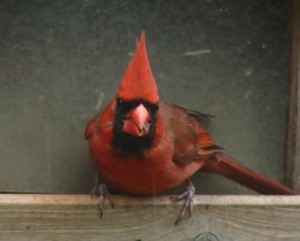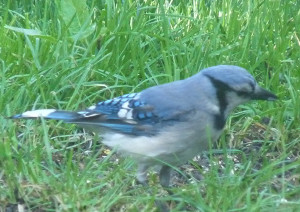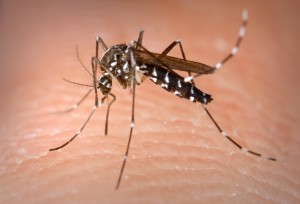Deborah and I have been keeping our eyes on some of the biological and ecological “events” of the summer of 2016. Since we have just slipped past the halfway point of the season, it’s time to think about some of these.
We have had some very successful reproductive efforts by the birds that visit our feeders and leaf piles! The cardinals and the robins have each had two nesting and fledgling cycles so far and seem to be starting up on another (both are out gathering new beaks-full of grasses and stems for their nests!). The chickadees and titmice have also gotten two nesting cycles done but seem to be less inclined than the cardinals or the robins to start into a third. The Carolina wrens also went through their usual mate re-shuffling kerfuffle in late June and have settled into a second nesting period.
The common grackles arrived at our feeders late in the spring, but they must have nested and fledged their young very quickly because there is now a robust flock coming to the feeders dominated by a large percentage of dark brown, immature birds. They swoop into the feeder areas about 10 am and especially like the scattered shelled corn (which they frequently dunk in the water of the bird bath before eating!). I am very tolerant of the grackles and put out extra corn for them at mid-day. I remember them voraciously eating gypsy moth caterpillars back in the gypsy moth explosion years of the 1990’s and want to continue to thank them for their efforts!
The blue jays and crows have completed their single nesting efforts and are now leading their fledglings around our complex habitats drilling them on food finding protocols and safety procedures. The first and second robin fledglings have gone from stumbling klutzes tripping through the leaf piles to confident, elegant hunters and efficient spearers of worms and caterpillars.
The mourning doves seem as though they have been mating all summer! I have lost track of how many nesting cycles they have gone through! The sharp-shinned hawks mated back in the late winter (the female was, as usual, extremely loud calling from the bare branches of our backyard black locust tree). Early in the morning we frequently see a sharp-shin swooping across the top of the front yard bird feeders. We also frequently find small piles of feathers (usually doves or cardinals) around the edges of our field. We have never seen, though, a sharp-shin fledgling! They are said to be secretive birds during reproduction and very wary of larger hawk predators (like goshawks and red-tails).
So, most of the birds seem to be behaving quite normally for a Western Pennsylvania summer, but many of the insects and other arthropods are acting quite oddly this year and they may be having some impacts on a wide variety of other species!
For example (and we are not complaining about this at all!), we have fewer mosquitoes around our house this summer. We are regularly sitting out on our deck well into the evening with minimal aggravation from buzzing and biting mosquitoes. These longer deck times, though, possibly go along with seeing fewer chimney swifts and fewer bats soaring over our field gobbling up all sorts of flying insects (but especially great numbers of mosquitoes!). The hummingbirds also came into our yard quite late this summer (they waited until the lure of the flowering bee balm in Deborah’s flower bed was overwhelming!). Hummingbirds are frequently described as “nectar powered insect eaters.” Possibly the lower numbers of mosquitoes reduced the feeding quality of our yard and field for the hummingbirds and caused them to linger elsewhere until the nectar scents were just too compelling!
Also, and we are not complaining about this either, there were no little “sugar ants” in the kitchen this spring! Every other May and June that we have been in this house (and in one week we will celebrate the 27th anniversary of our house closing!) we have had several weeks, at least, of columns of ants streaming in through tiny cracks around the kitchen window and door in search of any available crumbs or sticky residues. This year the ants did not show up! We think that these ants are mostly odorous house ants (Tapinoma sessile), but they may have been joined in bumper ant years, by the European exotic species called the pavement ant (Tetramorium caespitum). They are both little black ants that may fall into the very broad, common category of “sugar ant,” but one of them (“odorum”) gives off a bad smell when it is crushed. We seldom crushed any of them, but frequently washed a number of them down the drain.
Another insect change this year is a very small number of brown marmorated stink bugs (Halyomorpha halys ) emerging from their winter, in-house hibernations. Again, we have no problems with the direction of this change! I talked about this earlier this summer (Signs of Summer #3, June 16 2016). The lower numbers may be due to the growing activity of the predators of stink bug adults and eggs. Everything from spiders and chickadees to earwigs and katydids are now eating these exotic pests.
And finally, another arthropod that is less numerous and less active in our summer of 2016 ecosystems is the deer tick! We have had, along with most of Pennsylvania and much of the northeast, huge numbers of deer ticks in our rural and suburban ecosystems. These ticks are the arthropod vectors that spread the bacterium that causes Lyme disease, and as a consequence of their large numbers, Pennsylvania has had for the past few years the greatest number of Lyme disease cases in the country. Our yard and field have been a rich reservoir of these ticks. Walking out in the yard in sandals almost guaranteed you a tick or two, and our dog, Izzy, and our cat, Mazie, weekly (and sometimes daily!) picked up deer ticks from their forays within the fenced-in yard off of our deck. This spring and summer, though, we have found no deer ticks on either humans or pets! Further, our trampling around at Harrison Hills Park to check our bluebird houses also has not generated any ticks (a big change from last year!).
I am not sure why, and would like to ask everyone reading this post to think about your tick experiences this summer. Have you seen any deer ticks as a consequence of hiking or yard work or dog/cat interactions? Are we seeing some change in our deer tick populations?
Wow! Pennsylvania will surely get crowded with people if we start to have mosquito free and tick free summers! Real estate prices will go up! House sales will increase! Nothing but good things (unless you like chimney swifts and bats, of course).
More on all of this soon! Happy summer, everyone!







We do not see deer in our Lower Burrell yard very often, but, last summer we did have our first encounters with deer ticks (3). The last time being the day after Christmas when a deer tick found me while picking my still-growing parsley! Only found one more tick early this spring.
Last summer we also had so, so many butterflies visit our flower beds and a large variety of them. This summer there are very few butterflies to be seen. However, I am very happy to say that we have more honey bees than I’ve seen in years! Good to see them back!
Dr. Hamilton: We have not seen many ticks this summer on us or our dogs in Upper Burrell. We agree, the last two years the ticks were very abundant, but this year we only had one tick find a home on our Lab in the spring (April or May). Thank you for your posts!